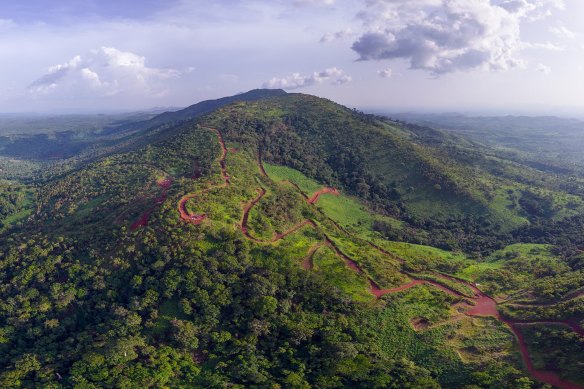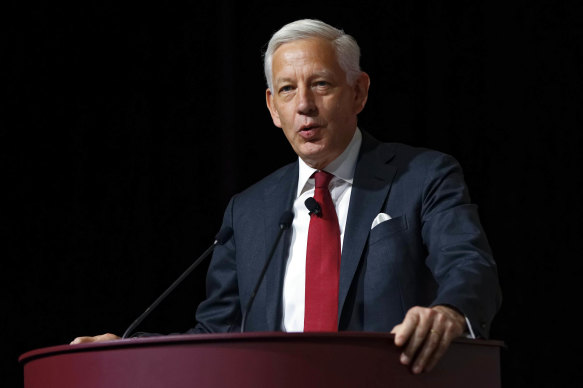By Nick Toscano
Mining giant Rio Tinto is planning to set new targets to address its impacts on the natural environment, as the industry comes under intensifying scrutiny for the scars it leaves on ecosystems and its contribution to biodiversity loss.
Rio Tinto, one of Australia’s largest miners, is part of a consortium building a huge new mining province in the forested Simandou mountains in the West African nation of Guinea, where there are fears for the survival of an endangered species of chimpanzee.

The Simandou mountains in Guinea contain high-grade iron ore.Credit: Rio Tinto
The Simandou iron ore project involves the construction of a 552km rail line to transport ore from the mines to a new deepwater port on Guinea’s Atlantic coast.
Speaking at an investor meeting in London, Rio Tinto chairman Dominic Barton said he had travelled to Guinea with two other directors in March, and met with four civil society groups that provided feedback about Rio Tinto’s operations and areas where the company needed to improve.
He indicated that Rio Tinto was preparing to enshrine new targets to mitigate the impact of its mining on the environment and animals in the region.
“We’ve been encouraged to forge ahead on establishing nature and biodiversity targets,” Barton said.
“We know we are not perfect ... where there are challenges, we need to keep getting around the table with our stakeholders, to develop better ways of working together to address these.”
Rio Tinto’s biggest rival, Melbourne-based BHP, signed up to a pledge in 2022 to conserve or rehabilitate 30 per cent of the land it owns or manages around the globe by 2030, as it sought to strengthen its “social value” credentials.
BHP’s prior commitment had been no “net loss” of biodiversity and no major environmental disturbance events, but the new targets set a goal to create “nature-positive” outcomes, it said.
The moves in the industry come as miners face growing pressure from institutional shareholders and wider society to do more to mitigate the damage their vast and emissions-intensive operations can have on the climate, environment and surrounding communities.

Rio Tinto chairman Dominic Barton.Credit: Trevor Collens
In a sign of powerful investors paying greater attention to environmental factors, social issues and corporate governance questions (known as “ESG” issues), a coalition of 190 fund managers last year signed up to the Nature Action 100 initiative, which has called on boards to publicly commit to minimising nature loss, conserve and restore ecosystems, and set science-based targets.
Rio Tinto sparked global condemnation for blowing up ancient and culturally significant Aboriginal rock shelters in Western Australia’s Juukan Gorge in 2020 to make way for an iron ore mine expansion.
The company’s new chief executive, Jakob Stausholm, appointed in 2021, has made a top priority of improving the company’s ESG performance and restoring trust with community stakeholders globally.
However, Rio Tinto’s environmental record faced renewed scrutiny at its annual general meeting this week, amid shareholder questions about allegations that the company’s majority-owned QIT Minerals may have contaminated waterways in southern Madagascar.
In Guinea, the Rio Tinto-backed Simandou project is believed to have some of the world’s richest iron ore deposits, but its development has been delayed for years amid disputes over infrastructure funding and various interventions from Guinea’s military junta, which seized power in a coup in 2021.
Rio Tinto has a 45 per cent stake in a consortium that owns two of Simandou’s iron ore tenements. The Winning Consortium, made up mostly of Chinese entities, owns the other two.
Iron ore, the key ingredient needed to manufacture steel, is Australia’s most valuable export, and is expected to rake in more than $130 billion in revenue this financial year alone.
However, analysts predict Guinea’s Simandou region may one day rival the iron ore volumes of WA’s iron ore-rich Pilbara region, while China is increasingly looking to Simandou as a way to lessen its reliance on Australian supplies.
The Business Briefing newsletter delivers major stories, exclusive coverage and expert opinion. Sign up to get it every weekday morning.